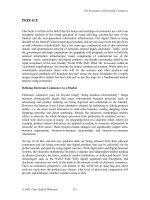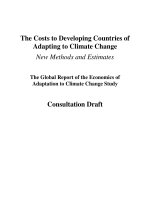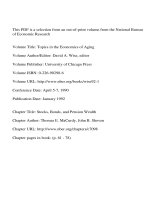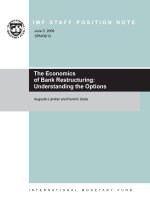The Economics of Taxation ppt
Bạn đang xem bản rút gọn của tài liệu. Xem và tải ngay bản đầy đủ của tài liệu tại đây (1.05 MB, 237 trang )
The Economics of
Taxation
This page intentionally left blank
The Economics of
Taxation
Bernard Salanie
´
The MIT Press
Cambridge, Massachusetts
London, England
This translation ( 2003 by the Massachusetts Institu te of Techn ology
Originally published in France under the titl e The
´
orie e
´
conomiquedelafiscalite
´
by Eco-
nomica, Paris
( 2002 by Economica
All rights reserved. No part of this book may be reproduced in any form by any
electronic or mechanical means (including photocopyi ng, recording, or informat ion
storage and retrieval) withou t permission in writing from the publisher.
This book was set in Palatino on 3B2 by Asco Typesetters, Hong Kong and was
printed a nd bound in the Unit ed States of America.
Library of C ongress Cataloging-in-Publicati on Data
Salanie
´
,Bernard.
[The
´
orie e
´
conomiquedelafiscalite
´
.English]
The economics of taxation / Bernard Salanie
´
.
p. cm.
Enl. translat ion of : The
´
orie e
´
conomiquedelafiscalite
´
.
Includes index.
ISBN 0-262-19486-4 (alk. paper)
1. Taxation. I. Title.
HJ2307 .S26 2002
336.2— dc21 2002035595
Contents
Foreword ix
Introduction 1
I The Effects of Taxation 13
1 Tax Incidence 15
1.1 Partial Equilibrium 16
1.1.1 The Effect of Payroll Taxes 16
1.1.2 The General Analysis of Partial Equilibrium 19
1.2 General Equil ibrium 23
1.2.1 The No-Taxation Ec onomy 23
1.2.2 Introducing Taxes 24
1.2.3 General Remarks 26
1.2.4 Infinitesimal Analysis 27
1.2.5 Final Rem arks 33
2 Distortions and Welfare Losses 35
2.1 The Effects of Taxat ion 38
2.1.1 Labor Supply 38
2.1.2 The Effects of Taxation on Savings 45
2.1.3 Taxation and Risk-Taking 49
2.2 Welfare Losses 52
2.3 Conclusion 57
II Optimal Taxation 59
3 Indirect Taxation 63
3.1 Ramsey’s Formula 63
3.1.1 An Informal Approach 63
3.1.2 The General Model 64
3.1.3 Some Special Cases 69
3.2 Productive Efficiency 73
4 Direct Taxation 79
4.1 The Emergence of the Model 79
4.2 Mirrlees’s Model 83
4.2.1 The Rawlsian Case 84
4.2.2 The General Approach 87
4.2.3 The Quasi-linear Case 91
4.3 Generalizations 96
4.4 Simulations 103
5MixedTaxation 111
5.1 The Negati ve Inc ome Tax 111
5.2 Is Indirect Taxation Useful? 113
5.3 Criticisms 117
6 The Taxation of Capital 121
6.1 Applying Classical Results 123
6.2 The Overlapping Generations Model 124
6.3 The Zero Capital Taxation Result 126
6.4 Capital Accumulation 129
6.5 Capita l Taxa tion with an Infinite Horizon 137
6.6 The Incidence of Capital Taxation 141
6.7 Conclusion 142
7 Criticisms of Optimal Taxation 147
7.1 Horizontal Equity 149
7.2 Tax Reforms 152
7.3 Administrative and Political Issues 155
III Some Current Debates 159
8 Low-Income Support 161
8.1 Measuring Poverty 162
8.2 Private Charity and Public Transfers 163
8.3 The Main Benefits 166
8.3.1 Guaranteed Minimum Income 167
8.3.2 The Negative Income Tax 168
8.3.3 Low-Wage Subsidies 168
8.3.4 The Minimum Wage 170
vi Contents
8.4 The Lessons from Theory 171
8.4.1 The Negative Income Tax 171
8.4.2 Low-Wage Su bsidies 176
8.4.3 The Guaranteed Minimum Income 179
8.4.4 The Minimum Wage 179
8.5 Empirical Evaluations 181
8.6 Recent Reforms 184
9 The Consumption Tax 187
9.1 Equivalences between Taxes 187
9.2 The Comprehensive Income Tax 188
9.3 The Consumption Tax in Practice 190
10 Environmenta l Taxat ion 193
10.1 Optimal Green Taxes 196
10.1.1 The First-Best Case 196
10.1.2 The Second-Best Case 198
10.2 Is There a Double Dividend? 200
Appendixes
A Some Basic Microeconomics 207
A.1 Consumer Theory 207
A.1.1 Hicksian and Marshallian Demands 207
A.1.2 The Sl ustky Equ ations 209
A.1.3 Interpretation 210
A.2 Producer Theory 211
A.2.1 The Producer’s Problem 211
A.2.2 Factor D emands 211
A.2.3 The Sp ecial Case of Constant R eturns 213
B Optimal Control 215
Index 219
Contents vii
This page intentionally left blank
Foreword
This book is a somewhat expanded translation of my The
´
orie e
´
cono-
miquedelafiscalite
´
, published by Economica in Paris. It originates
inacoursetaughtatENSAEandattheUniversityofChicago.I
have greatly benefited from the reactions of the students who went
through these courses. I thank without implicating Arnaud Buisse
´
,
Dominique Bureau, Paul Champsaur, Pierre-A ndre
´
Chiappori, Maia
David, Ste
´
phane Gauthier, Anne Laferre
`
re, Guy Laroque, Thomas
Piketty, Jean-Charles R ochet, F ranc¸ois Salanie
´
, Jean-Luc Schneider,
Alain Trannoy, and especially Philippe Chone
´
for their comments on
a first version of this text. I am also grateful to Christian Gourie
´
roux
and six anonymous reviewers for their comments.
This page intentionally left blank
Introduction
The word ‘‘taxation’’ may take different meanings. In the stricter
sense, taxation is the set of tax es that economic agents pay. In the
larger sense, it concerns the whole fiscal policy of governments. I
willuseitinanintermediatesense.Inthisbook,taxationrefersboth
to taxes and to transfers to hou seholds. These transfers are usually
classified in two categories:
.
social insurance, which is linked to contributions (depending on
countries: pensions, health, family, and/or unemployment benefits)
.
social welfare, which pays benefits that do not depend on e arlier
contributions (e.g., minimum income benefits or housing subsidies).
This distinction is somewhat artificial as insurance also implicitly
redistributes across social classes. Thus health contributions often
depend on income, whereas health risks are only weakly correlated
with income. Even when benefits are linked t o contributions (as is
often the case for pay-as-you-go pension systems), the risk may be
strongly correlated with income ( thus the rich usually live longer
than the poor). Here I will include in taxation all taxes and benefits
that come between an individual’s gross income and his purchas-
ing power. Howeve r, I will a dopt a microeconomic viewpoint. I will
therefore not study, for instance, the use of taxation to stabilize the
economy.
Thus defined, taxation is a very rich and varied topic. Govern-
ments have resorted to all sorts of taxes in history, all the while
invoking reasons that went from simple expediency to enlightened
paternalism. Still, one can find common threads. Thus this introduc-
tion begins with a brief historical survey. Then it will give some data
on taxation in developed countries. Finally, it gives a road map to
therestofthebook.
Some History
As far as we know, taxes appeared concomitantly with civilization in
Mesopotamia and in Egypt, as can be seen from Sumerian tablets
dated 3,500 bc. In these despotic regimes, the king’s own resources
were not enough to provide a living for his p riests, his court, and his
army, so he had to resort to taxes. As the use of money was still rare,
most of these taxes were paid in kind. Thus the peasants that con-
stituted most of the population must bring to the king a fixed pro-
portionoftheircrops(e.g.,one-fifthinEgyptandone-tenthinSumer
at times).
1
They moreover had to provide labor to maintain public
equipments, but also to build pyramids and t emples or to work the
king’s fields.
Athens and Rome went further by taxing sales of land and slaves
and raising import duties. They also tried (and mostly failed) to tax
capital and property. For many centuries yet, taxes would mostly fall
on peasants. The fall of the Roman empire brought its tax system
down with it. For a long time each local authority lived mostl y on
the produce of its own land. The emergence of the feudal system
imposed the principle that everyone, from the peasant to the duke,
must provide either military service or labor in return f or the right
to till his land. Monetary taxes now came in addition to labor and
in-kind taxes; they could be indirect taxes (pai d on transactions of
goods) or direct taxes (paid on wealth or on income). Many cities
moreover negotiated charters w ith the k ing so as to o btain tax
privileges.
In several countries the principle of consent was established early:
any new tax must be agreed to by the subjects (n’impose qui ne veult).
The most famous example is the Magna Carta granted by King John
of England to his barons in 1215; it stated that no tax could be raised
without the consent of Parliament. Much later, this notion of course
led to the American War of Independence, with the cry of ‘‘no taxa-
tion without represen tation.’’
The t ax systems did not change much until the Industrial Revolu-
tion; to obtain higher revenu e, governments mostly multiplied taxes
on specific goods (called excises) and custom duties, internal (be-
1. Given the logistical difficulties at the t ime, these contri buti ons were ofte n collected
by ‘‘tax farmers,’’ who owed a fixed amount to the king and might collect twice as
much to obtain a tidy profit. This practice of tax farming was due to persist until the
nineteenth ce ntury.
2Introduction
tween provinces) as well as external. The French Revolution had
important consequences, though. In England and in other European
countries, the need to finance the Napoleonic wars led governments
to create the first modern income taxes. However, these taxes were
abolished when peace returned. The increasing influence of liberal
ideas on the virtues of free t rade translated in the nineteenth cen-
tury into a notable decrease in custom duties, w hich reduced tax
revenue. To plug this hole, the English prime minister Robert Peel
re-established an income tax in 1842. The other countries f ollowed
suit, when the yearning for more equality and the need t o finance the
firstelementsofthewelfarestatebecamestronger.ThustheUnited
States only created an income tax in 1913, after overcoming t he con-
stitutional objections of the Supreme Court. Until then, federal tax
revenues mostly came from custom duties and the so-called sin taxes
on tobacco and alcohol.
The early income taxes were not very progressive : thus the English
income tax was proportional to income, beyond a personal exemp-
tion. Only in 1909, after a homeric b attle with the House of Lords,
could Lloyd George created a ‘‘surtax’’ for high i ncomes. However,
the US income tax, which was created later than the English one,
was progressive from the start. One should note here that before
the First World War, governments only collected a small part of
national income: less than 10 percent, or even less than 5 percent in
the United States. Even though income taxes were becoming more
and more important, their rates seem very small today: the basic rate
was a few percentage points of income, and the top rate was every-
where below 15 percent. Given large personal exemptions,
2
only a
small percentage of the population (about 2 percent in the United
States) actually paid the income tax. The personal income tax thus
was a ‘‘class tax,’’ just as the corporate income taxes that emerged in
thesameperiod.
Twomainfactorsexplainthelargeincreaseintaxrevenueduring
the twentieth century: the two world wars, and the emergence of the
modern welfare state. During each world war, military expenditure
reached or passed half of national income in the main warring
countries. Some countries financed this explosion in public expendi-
ture by borrowing, but most countries resorted to tax increases. Thus
2. For in stanc e, an American taxpayer only paid income tax in 1913 on the fraction of
his income that exc eeded five times th e average income.
Introduction 3
the top marginal rate of the income tax reached 77 percent in the
United States in 1918. Moreover the Second World War transformed
the income tax into a ‘‘mass tax’’ that touched more than half of all
households, with the creation of pay-as-you-earn systems in the
United Kingdom and the United States. In both count ries the top
marginal rate became confiscatory at the end of the war (at 94 per-
cent in the United States and no less than 97.5 percent in the United
Kingdom!).
One would expect tax rates to go back to normal after each war.
As a matter of fact, tax rates did decrease in the 1920s. However, the
strong increase of social expenditure took the lead in raising the tax
take. The welfare state was b orn in the Prussia of Bismarck, with
the creation of comp ulsory health insurance in 1883 and a pension
system in 1889. Other countries followed suit in the first half of
the twent ieth century: u nemployment benefits were created in the
United Kingdom in 1911, in 1927 in Germany, in 1931 in France, and
in 1936 in the United States, pension systems in 1909 in the United
Kingdom and in 1935 in the United States. Th e famous Beveridge
report consolidated the system in the United Kingdom after 1945. All
these reforms contribu ted to an explosion of social expenditure that
canbeseeninthestrongincreaseoftheshareoftransfersinpublic
expenditure in all of these countries over the last hundred years.
The value-added tax (VAT) was introduced in France in the 1950s.
It has now become a central tool of tax policy in most developed
countries, with the exception of the United States. It was institu tion-
alized in the European Union by several directives in the 1970s.
In the 1980s there were spectacular fiscal re forms in sever al coun-
tries, especially in the United States and the United Kingdom after
rightist governmen ts cam e to power. The t op mar gina l rate of the
income tax in the United States was 70 percent at the end of the
1980s; it was reduced to 50 percent in 1981, then to 28 percent in
1986. In the U nited Kingdom, Mrs. Thatcher brought down the top
marginal rate from 83 percent
3
to 40 p ercent. In both countries the
rate of the corporate income tax was also lowered.
4
The governments
that succeeded President Reagan and Mrs. Thatcher mostly stuck to
these changes, even though President Clinton raised the top mar-
3. Not including a surcharge of 15 percent on capital income, which took the marginal
rate to 98 percent for some taxpayers.
4. In the United States the tax basis became more comprehensive at the same time,
and the final effect was an increase in corporate t ax revenue.
4Introduction
ginal rate to 39.6 percent.
5
The m ain continental European countries
have adopted more modest reforms.
Current Ta x Syst ems
As shown in the preceding section, current tax systems are the
product of a long evolution marked by historical accidents; not sur-
prisingly, they vary a lot across countries. Steinmo (1993) shows
clearly, in the examples of the United States, the United Kingdom,
and Sweden, how p olitical systems condition the tax policy of states.
There are nevertheless feature s that are common to l arge grou ps of
countries.
First consider the developed countries. Table I presents figures
from OECD (1999) on the evolution of the share of taxes in GDP for
the five largest economies,
6
for the unweighted average of all OECD
countries, and for the unweighted average of the fifteen countries
that today constitute the European Union. There are clearly large
differences, with the United States and Japan in a low-tax group and
France a high-tax c ountry; moreover these international differences
tend to persist over time. The tax take is procyclical, so one should
not make too much of its precise value in individual years. Still, one
can see in the table the large expansion in the tax take in the 1970s,
followed by a pause starting in the 1980s that actually led to fiscal
retrenchment in Japan and the United Kingdom.
Table II shows the breakdown of tax revenue into its main com-
ponents in the se five c ountries and groups of countri es in 1997. The
Table I
Tax revenue as a percentage of GDP
1965 1980 1990 1997
US 25.0 27.6 27.6 29.7
Japan 18.3 25.4 30.9 28.8
Germany 31.6 38.2 36.7 37.2
France 34.5 41.7 43.0 45.1
UK 30.4 35.1 36.3 35.4
OECD 25.8 32.8 35.6 37.2
EU15 27.8 36.9 40.3 41.5
5. The Tax Relief Act of President Bush should l ower it to 35 percent in 2006.
6. For Germany, read Western Germany until 19 91, then reunified Germany.
Introduction 5
shares of tax reve nue from each tax are indicated as PIT personal
income tax, CIT c orporate income tax, and SSC social security con-
tributions. ‘‘General’’ designates general consumption taxes (includ-
ingVATandsalestaxes)and‘‘specific’’taxesonspecificgoodsand
services (mainly excises and custom duties).
ThemaintaxrevenueofOECDcountriesisthepersonalincome
tax, with more than a quarter of the tax take. Several countries have
reduced the number of t ax brackets a nd the corresponding tax rates
in recent years, while others have made more modest changes. As a
result the share of the PIT in tax revenue has gone down a bit, but it
varies a lot across countries. Other differences persist, for instance, in
accounting for differences in household composition. Thus a major-
ity of countries taxes the two members of a couple separately (as in
the United Kingdom); taxation may also be joint as in France for
married couples, or at the choice of thecoupleasintheUnitedStates
and Germany. Children give access to c hild credits in the United
Kingdom and the United States, while France uses income splitting.
Finally, note that the income tax is usually deducted directly from
the paycheck (the pay-as-you-earn system).
Social contributions are the second largest source of revenue in
the OECD, and the largest one in France, Germany, or Japan. Their
share of tax revenue has constantly increased, with the increase in
social transfers: they represented only 18 percent of the tax reve-
nue in 1965. These social contributions are usually paid as a pro-
portional tax on wages, sometimes under a ceiling as in the United
States.
The third largest resource is the ‘‘general’’ consumption tax, which
hits all consumption goods; in most OECD countries it is t he VAT
Table II
Components of tax revenue
PIT CIT SSC Property General Specific
US 39.0 9.4 24.2 10.7 7.8 6.8
Japan 20.5 15.0 36.9 10.8 7.0 7.6
Germany 23.9 4.0 41.6 2.7 17.6 9.0
France 14.0 5.8 40.6 5.4 17.8 8.8
UK 24.8 12.1 17.2 10.8 19.5 13.9
OECD 26.6 8.8 24.9 5.5 18.0 12.4
EU15 25.5 8.5 28.6 4.5 17.8 11.5
6Introduction
(but it is the sales tax in the United States). Its share in tax revenu e
has jumped from about 12 percent in 1965 to 18 percent in 1997. In
the form of VAT, it is even more dominant in m iddle-income coun-
tries and less developed countries. It often has seve ral rates, with a
reduced rate on necessities, and even a zero rate sometimes (as in the
United Kingdom).
On the other hand, the share of excises (specific taxes that are
levied on the consumption of a given good, e.g., alcohol, tobacco,
and gasoline) has strongly declined over the last thirty years. While
these taxes were the main resource of governments until the nine-
teenth century, they now constitute only 12 percent of the tax reve-
nue in the OECD.
The other two tax resources (the corporate income tax and the
property taxes) are usually classified as taxes on capital. The most
striking feature of these two taxes is that their share in tax revenue
varies enormously across countries. The share of corporate income
taxes has been fairly constant across time; this hides a smal l reduc-
tion in rates and a recovery in the taxable basis (profits). In most
countries the corporate income tax only hits incorporated firms; the
profits of other firms are taxed as part of the personal income of their
owners. The computation of the corporate income tax liability of a
firm follows a number of r ules that concern the treatment of capital
gains, depreciation, provisions, and past losses among other things.
As a consequence the effective revenue of the tax may be higher in a
country where its nominal rate is lower. The double taxation of divi-
dends is another crucial difference across countries. In the ‘‘classical
system’’ that prevails in th e United States, dividends are taxed by the
corporate income tax (as redistributed profits) and then by the per-
sonal income tax (as income of shareholders). Most other countries
have taken steps t o cancel this double taxation.
Property taxes are very diverse. They include among others
wealth taxes, taxes on bequests, taxes on gifts inter vivos,taxeson
capital gains, and taxes on land and housing. Once again, there are
strong variations across countries. Perhaps surprisingly, the United
Kingdom and the United States tax property more heavily than
France or German y.
To conclude this short survey of current tax systems, we should
add that taxation varies even more across less developed countries.
The tax take is much smaller there than in developed countries, at
around 20 percent of GDP. In transition economies, the tax take has
Introduction 7
been moving toward OECD levels.
7
Less developed countries lack an
efficient tax administration, which orients their tax revenue toward
taxes that are easier to collect. Thus indirect taxes constitute two-
thirds of their resources, with custom duties bringing in one-third of
tax revenue.
8
Thepersonalincometaxbringsamuchsmallershare
of tax revenue than in OECD countries, and taxes on capital are
almost nonexistent, given the difficulty to properly assess the taxable
basis of these taxes.
Overview of the Book
In his classic book, Musgrave (1959) distinguished the three main
functions of governmen t:
.
allocation, to provide public goods and remedy market failures
.
redistribution
.
stabilization, as pertains to m acroeconomic interventions (incl ud-
ing automatic stabilizers).
We will set aside here a study of stabilization, which can be found in
any good macroeconomic textbook. We will focus on the first two
functions.
In the Arrow-Debreu mode l the second f undamental welfare the-
orem shows that under some assumptions, every Pareto optimu m
can be decentralized as a competitive equilibrium of a private
property economy where resources have b een redistributed through
lump-sum transfers.
9
When this theorem applies, the government
can choose its preferre d Pareto opt imum, proceed to the right lump-
sum transfers, and let the competitive equilibrium work i ts m agic
without any other kind of intervention.
In practice, we observe several phenomena that lead to market
failures (e.g., see Salanie
´
2000). First come public goods: these are by
definition the nonrival goods, which one agent can consume without
reducing the consumption of other agents. Then the second theo-
rem does not apply any more (technically, consumptions do not add
7. Russia is a notable exception: taxes there collect only half of their theoretical reve-
nue, and the tax take is only about 10 percent of GDP.
8. By contrast, tariffs today bring less than 1 percent of tax reven ue in OECD coun-
tries, as compared to about 15 perc ent in the early twentieth century.
9. Recall that the defining property of lump-sum transfers is that th ey only depend on
the identity of agents , and not on their economic transactions.
8Introduction
across agents). The optimal production level for the public good
cannot be attained without an intervention of government. Moreover
these public goods must be financed, which raises the classical free-
rider problem.
The presence of external effects also implies that the market cannot
reach an optimum on its own; corrective taxes are one way to
remedy this market failure (as with ecotaxes designed to reduce
pollution).
Adam Smith alre ady considered that the prince must provide
three categories of public goods to his subjects: defense, justice, and
public works, plus a private good subject to externalities: primary
education.
10
Even the most liberal thinkers
11
(the so-called l iber-
tarians, whose viewpoint is well expressed by Nozick 1974) accept
a ‘‘minimal state’’ that provides defense and justice ; free-rider prob-
lems indeed make it impossible to leave them to th e private sector.
Even in the (hypothetical) absence of these market failures, lump-
sum transfers are very unlikely to be a practical proposition. Com-
puting the optimal lump-sum transfers requires government to have
an extraordinarily detailed information on the characteristics of
the economy. One may mention two attempt s in history to imple-
ment (obviously nonoptimal) lump-sum transfers. The first one is
capitation, which levied on each head of household a tax that only
depended on its social status (but sometimes also on wealth, which
violatedthelump-sumcharacterofthetax).Thesecondoneismore
recent, with the poll tax proposed in the United Kingdom by Mar-
garet Thatcher . Thi s aimed at replacing a propert y tax on housing
that depended on the estimated value of property; the poll tax
would only have varied across areas. Since taxpayers can still move
between communities, once again it was not a strictly lump-sum tax.
In any case, the poll tax project led to violent demonstrations in the
spring of 1990; it was abandoned and contributed heavily to the later
fall of Mrs. Thatcher.
Thus, in order to finance public goods (or publicly provided pri-
vate goods such as education and health) as well as in order t o re-
distribute, the government must use non –lump-sum transfers, which
by definition depend on t he de cisions of private agents. As a con-
sequence each taxpayer may reduce his tax bill by changing his
10. On the other hand, he th ought that higher education must be left to the private
sector, w ith teachers p aid on a p erforman ce basis (hor resco referens).
11. Iuseheretheword‘‘liberal’’initsclassical,non-USsense.
Introduction 9
behavior, and he will try to do so as long as the game is worth
the candle. It is obviously crucial to be able to evaluate the impor-
tance o f these incentive effects of taxes. Moreover taxes create a bias
among the marginal rates of substitution of various agents, which
induces social welfare losses. Once again, a good economist should
be able to quantify these losses: available studies show th at they may
amount to between 10 percent and 5 0 percent of tax revenue , which
is considerable. These two themes constitute the essence of the first
part of the book, which deals with p ositive economics.
The second part of this book adopts a resolutely normative stance.
It is clear by now that real-world taxes, which are not lump-sum,
reduce the inefficiency of the economy. How then is the governement
to choose an optimal tax system? We will see how this question can
be modeled, and what partial answers can be given.
These two parts are mostly theoretical, even though we try to in-
troduce empirical and institutional elements as needed. However,
economic policy questions rarely reduce to simple models. To show
how these questions can be studied in the light of the results
obtained in the first two parts, we examine in a third and last part
three current tax policy debates: low-income support, the consump-
tion tax, and envir onmental taxation.
A warning is in order he re. The positive study of taxation does not
reduce to the ele ments given in the first part of this book. One may
want to go beyond the study of the effects of taxation on economic
decisions of private agents and t o model the w ay a c ommunity
decides on its tax system. This qu estion concerns the political econ-
omy of taxation, which has developed a lot in the last twenty years.
To keep this book from expanding beyond a reasonable length, this
aspect will not be studied here. The reader will find references on the
public choice approach in Hettich-Winer (1997). The book by Persson-
Tabellini (2000) gathers different perspectives to give a very com-
plete survey of modern political economy; its chapters 6 and 12 are
particularly oriented toward taxation issues.
Reading this book requires the knowledge of microeconomics at
the advanced undergraduate level. An appendix presents the main
results that are used in the text. Moreover the study of optima l tax-
ation r elies on the theory of optimal control. Since this is often not
taught in economics curricula, we give the necessary notions in
another appendix.
10 Introduction
References
Hettich, W., and S. Winer. 1997. The political economy of taxation, ch. 22 of Per-
spectives on Public Choice,D.Mueller,ed.,CambridgeUniversityPress.
Musgrave, R. 1959. The Theory of Public Fin ance . McGraw Hill.
Nozick, R. 1974. Anarchy, State and Utopia. Basic Books.
OECD. 1999. Revenue Stat istics 1965– 1 998.OECD,Paris.
Persson, T., and G. Tabellini. 2000. Political Economics.MITPress.
Salanie
´
, B. 2000. The Microeconomics of Market Failures.MITPress.
Steinmo, S. 1993. Taxati on and Democracy. Yale University Press.
Introduction 11
This page intentionally left blank
I
The Effects of Taxation
The first part of this book is dedicated to the study of the economic
effects of taxation. Assume, for instance, that government decides to
raise the VAT on sales of cars. The political effects of such a measure
are predictable: car producers will complain that their sales will de-
crease, and car buyers will fear a rise in the price of c ars. Bu t who
does really bear the price of such a rise in VAT, and in what pro-
portions? Chap ter 1 studies thi s qu estion, first in a partial equilib-
rium, then in a general equilibrium framework.
Another often debated question is that of the disincentive effects of
taxation, as in the negative effect of the income tax on labor supply.
Any tax measure will prompt agents to change their behavior so a s
to pay less taxes. We examine in chapter 2 the mechanisms that
change the m ain behaviors. We show there how the social losses
induced by taxation can be evaluated. It is very important to under-
stand both of these points well before moving to the discu sssion of
optimal taxation in the second part of this book.
This page intentionally left blank









